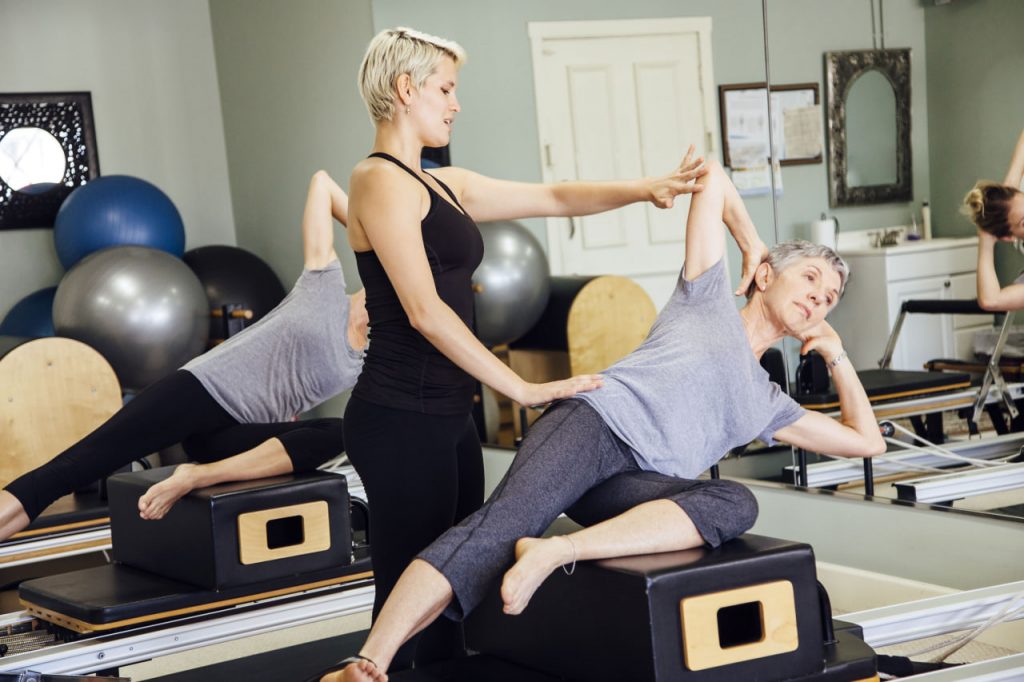Pilates is a unique form of exercise that combines strength training, flexibility, and mindful movement to build a strong, healthy body. While many people are drawn to Pilates for its focus on core strength and flexibility, the science behind the practice reveals why it’s so effective and how it can benefit various aspects of your health.
In this article, we will explore the science behind Pilates and how its principles work to improve both physical and mental well-being.
1. Core Engagement and Muscle Activation
One of the primary focuses of Pilates is the engagement of the core muscles, including the abdominals, lower back, and pelvic muscles. By training the deep stabilizing muscles, Pilates helps improve posture, prevent back pain, and increase stability.
How it works: Pilates exercises involve controlled movements that require conscious muscle activation. For example, during exercises like the “Hundred” or “Roll Up,” the deep abdominal muscles are engaged to support and stabilize the spine. The movements are performed slowly to ensure proper alignment and to activate the right muscles at the right time.
Why it’s effective: Research has shown that strengthening the core improves not only posture but also enhances overall athletic performance and reduces the risk of injury. A strong core supports proper alignment, which is essential for efficient movement in all physical activities, from daily tasks to sports.
2. Breathing and Oxygen Flow
A key element of Pilates is its emphasis on breathing, which helps regulate movement and increase oxygen flow throughout the body. Pilates encourages deep, controlled breathing patterns that promote relaxation and focus.
How it works: Pilates uses a specific type of breathing called “lateral breathing.” Instead of shallow chest breathing, lateral breathing involves expanding the ribs outward and filling the lungs with air from the sides, rather than from the front and back. This helps to engage the muscles of the torso more effectively, supporting spinal alignment and core engagement.
Why it’s effective: Deep breathing helps to increase oxygen flow to the muscles and tissues, reducing fatigue and improving performance. It also activates the parasympathetic nervous system, promoting relaxation and reducing stress. Proper breathing is essential for controlling the movement and maximizing the benefits of each Pilates exercise.
3. Flexibility Through Controlled Stretching
Flexibility is another key component of Pilates. The practice incorporates stretching movements that improve joint mobility and muscle flexibility, which can help reduce the risk of injury and enhance overall movement efficiency.
How it works: Pilates incorporates dynamic stretching techniques that gently lengthen muscles while maintaining a controlled range of motion. Movements such as the “Saw” and “Spine Stretch” actively stretch the spine, hamstrings, and other major muscle groups. The slow and deliberate pace of Pilates exercises ensures that muscles are stretched in a safe and effective manner.
Why it’s effective: Improving flexibility through Pilates not only helps increase joint range of motion but also aids in muscle recovery after workouts. Flexible muscles are less prone to injury and can move more freely during everyday activities and physical exercises.
4. Mind-Body Connection
Unlike many other forms of exercise, Pilates places a strong emphasis on the mind-body connection. Each movement is performed with a high level of focus and concentration, which requires participants to be mentally present throughout the entire workout.
How it works: Pilates encourages mindfulness by directing attention to the body’s movements, posture, and breath. This focus helps individuals maintain proper alignment and engage the correct muscles during each exercise. By maintaining focus, Pilates practitioners can avoid overexertion, ensure proper technique, and prevent injury.
Why it’s effective: The mind-body connection in Pilates fosters better awareness of how the body moves, improving overall body control. This awareness translates to improved posture, more efficient movement, and increased physical confidence. Mindfulness also reduces stress, promotes relaxation, and improves mental clarity.
5. Low-Impact Nature of Pilates
One of the key benefits of Pilates is that it is a low-impact workout, making it suitable for a wide range of people, including those recovering from injuries or dealing with chronic pain. Pilates exercises are typically performed on a mat or using specialized equipment like the Reformer, which allows for controlled, non-strenuous movements.
How it works: Pilates exercises focus on controlled movements and precise alignment rather than high-intensity or high-impact exercises. Most exercises can be modified to suit different fitness levels, from beginners to advanced practitioners, ensuring a safe and effective workout for all.
Why it’s effective: The low-impact nature of Pilates makes it gentler on the joints and muscles compared to other forms of exercise. It’s an excellent option for those looking to build strength, improve flexibility, and rehabilitate injuries without putting undue strain on the body.
6. Enhancing Mental Focus and Reducing Stress
Pilates is known for its ability to enhance mental clarity and focus. The practice encourages concentration and awareness, which can help reduce mental stress and improve emotional well-being.
How it works: During Pilates sessions, participants are asked to focus on their breath and the precision of each movement. This mindfulness helps shift the focus away from external distractions, allowing practitioners to immerse themselves in the present moment.
Why it’s effective: Mental focus and mindfulness are proven to reduce anxiety and stress, while also improving cognitive function. Pilates has been shown to enhance emotional regulation, making it a great option for individuals seeking to manage stress and promote relaxation.
Final Thoughts:
Pilates is a science-backed form of exercise that offers a wide range of physical and mental benefits. From strengthening your core to improving flexibility and mental clarity, Pilates is a holistic workout that can be tailored to your fitness goals. Whether you’re new to exercise or looking to deepen your practice, Pilates offers a safe and effective way to enhance your overall health and well-being.
Join us at Pilates Power School to experience the transformative benefits of Pilates firsthand!

